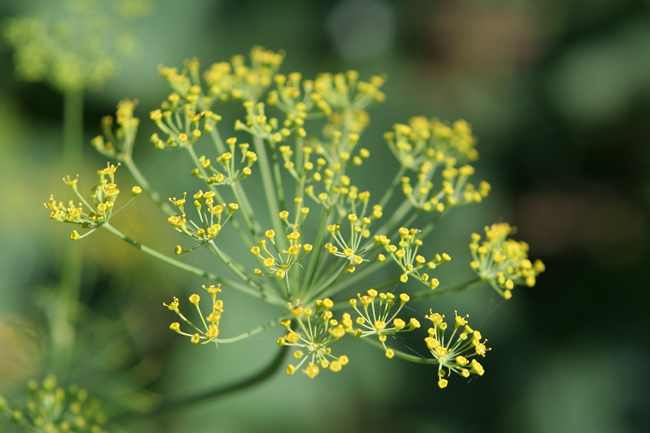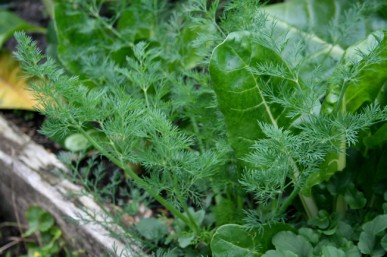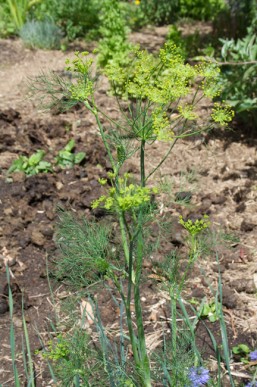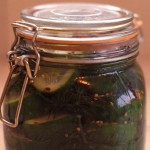Dill, Anethum graveolens, is a delightful tall annual herb that grows to about 1 m from a taproot, with a single stem and many feathery blue-green leaves and branches. These are topped by groups of umbrella-shaped flower heads made up of small yellow flowers. The flowers are followed by flat, oval, brown seeds, which self-sow readily if left on the plant. Dill is probably one of the oldest medicinal herbs. It was used by the Egyptians before 3000 BC. The name dill is found in several old European languages, reflecting its widespread use, but its derivation is unclear. In medieval times, dill developed a reputation for protecting anyone who carried it against witches. It was a common ingredient in potions and spells and English country brides would wear a sprig of dill on their wedding day, while in Germany, a bride would put dill and salt in her shoes to bring her good luck. By the beginning of the seventeenth century dill was grown in many countries all over the world because it was known as ‘a gallant expeller of wind’.
Sowing, growing, harvesting
Grow dill from seed sown preferably in spring where the plants are to grow, as they do not transplant well. In warm weather, the plants will mature in about seven weeks, so small numbers of seeds will need to be planted every few weeks to be sure of a constant supply of fresh leaves. Dill grows in most well-drained soils and likes full sun. Dill tastes best if you pick the leaves just before use but if they have to be picked earlier, store in the refrigerator in a plastic bag. I never bother to dry dill as the leaves don’t hold their flavour well when dried. But the seed is well worth drying. Harvest seed just as it starts to turn from green to brown. Dry by hanging upside down in bunches with the seed heads covered by paper bags.� Once the seeds are completely dry they will have dropped into the bottom of the bags. Dill and fennel are similar to look at but the leaves of dill are more blue-green, and the flavour of fennel is more strongly aniseed.
Remedies
The ground or gently bruised seed is the part generally used and it has wide range of uses. Chew the seeds to sweeten the breath. Ground seeds, added to a biscuit mixture for teething babies to chew on, are very soothing. Give a diluted, strained infusion made from the seeds to soothe colic. If drunk by nursing mothers the effect will be passed on to babies through the milk as well as increasing milk flow. Dill also helps with acidity, indigestion and flatulence in adults. Drink an infusion made from the seeds to calm and tone the digestive system, ease indigestion and acidity and reduce flatulence.
Eating
Try adding a few dill leaves to your next sandwich. It goes really well with cucumber and fish like tuna or salmon. Also add fresh leaves to dip, salads, soups and stir fries. It makes a decorative garnish too. The seeds are added to a range of different spice mixes as well as breads and preserves and pickles.
Dill pickle
3 small firm cucumbers
2 handfuls of fresh dill leaves
50 g coarse salt
1 teaspoon dill seeds
1 teaspoon black peppercorns
half a teaspoon mustard seed
4 cups water
half a cup white wine vinegar
clean medium-sized screw-top jar
1) Wash and dry the cucumbers and place them with the dill in the refrigerator while you prepare the vinegar mixture.
2) Place the salt, dill seed, peppercorns, mustard seed, water and vinegar into the saucepan. Bring to the boil, simmer for 3 minutes, remove from the heat and leave to cool slightly.
3) Place the jar in the oven (remove any rubber seals first) and heat to 180°C, leave for 10 minutes. Turn off the oven and allow the jar to cool.
4) Remove the cucumbers and dill from the refrigerator, slice the cucumber into thick slices, about 5 mm, and roughly tear the dill into smaller pieces. Pack the cucumber and dill into the jar in alternate layers.
5) Pour the vinegar, spice and water mixture over the top. Make sure that the cucumbers are completely covered and that all the spices are tipped into the jar. Discard any excess liquid.
6) Seal tightly and leave to sit in a cool, dark position for about 3 weeks before opening. Once the jar has been opened keep it in the refrigerator.
This recipe is from my book Growing Easy Herbs for Beauty Fragrance and Flavour




